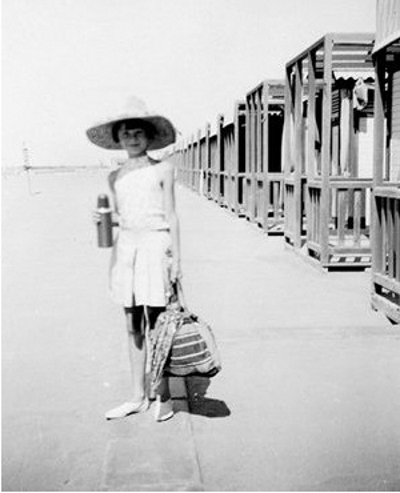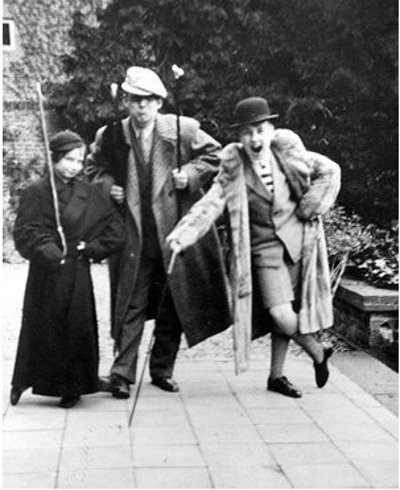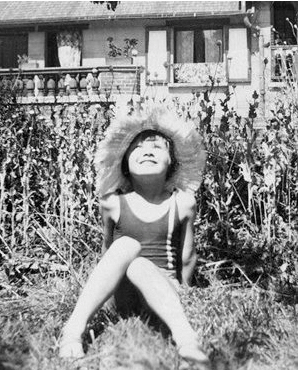All of the artwork in this post was done by Audrey Hepburn during World War II.

Audrey at the beach in 1937, 8 years old, before the war.Living is like tearing through a museum. Not until later do you really start absorbing what you saw, thinking about it, looking it up in a book, and remembering — because you can’t take it all in at once.
In 1939, Audrey Hepburn’s mother Ella moved Audrey and her two half-brothers from Belgium to their grandfather’s home in Arnhem, in the Netherlands. She believed they would be safe there. On May 10, 1940, six days after Audrey’s eleventh birthday, the Wehrmacht invaded the Netherlands, having already come through Luxembourg and Belgium. The Germans called their campaign of invasion of the Low Countries “Fall Gelb;” in Dutch, the Nederlanders refer to it as “Slag om Nederland,” or, “Battle for the Netherlands.”

Audrey passed much of her time outside of school during the occupation drawing.
Completely hemmed in and outmanned by the German army, the Dutch main force in the Netherlands nonetheless held out for five days in mid-May, 1940 — a small contingent near Zealand held off the Wehrmacht through the 17th, but finally surrendered after grave loss of life. Almost exactly five years later, the final Dutch province was liberated.
During the five-year occupation of Arnhem, besides spending her time drawing and performing openly in plays with her mother and friends, Audrey attended school under the name “Edda van Heemstra,” a pseudonym invented by her mother Ella that she hoped would not betray Audrey’s English roots.

Audrey in costume for one of the plays in which she and Ella performed to raise spirits in the town during the occupation.
Audrey trained in ballet and secretly performed for small, sympathetic groups to raise money for the Dutch Resistance.
“The best audience I ever had made not a single sound at the end of my performances.”

1939 — age 10.
I was exactly the same age as Anne Frank. We were both 10 when war broke out and 15 when the war finished. I was given the book in Dutch, in galley form, in 1946 by a friend. I read it and it destroyed me. It does this to many people when they first read it, but I was not reading it as a book, as printed pages. This was my life. I didn’t know what I was going to read. I’ve never been the same again, it affected me so deeply.
During the Dutch famine over the winter of 1944, the Germans confiscated the Dutch people’s limited food and fuel supply for themselves. Without heat in their homes or food to eat, people in the Netherlands starved and froze to death in the streets. Hepburn and many other Dutch people had to resort to using flour made from tulip bulbs to bake cakes and cookies.
Arnhem was devastated during allied bombing raids that were part of Operation Market Garden. Audrey’s older brother Ian was sent to a labor camp, and her uncle and cousin were shot in front of her for being part of the Resistance.

Audrey and her brothers Anthony and Ian playing in 1938.
We saw reprisals. We saw young men put against the wall and shot and they’d close the street and then open it and you could pass by again. If you read the diary [of Anne Frank], I’ve marked one place where she says, ‘Five hostages shot today’. That was the day my uncle was shot. And in this child’s words I was reading about what was inside me and is still there. It was a catharsis for me. This child who was locked up in four walls had written a full report of everything I’d experienced and felt.

In Belgium in 1934, five years before the war broke out.
I have memories. More than once I was at the station seeing trainloads of Jews being transported, seeing all these faces over the top of the wagon. I remember, very sharply, one little boy standing with his parents on the platform, very pale, very blond, wearing a coat that was much too big for him, and he stepped on to the train. I was a child observing a child.
When the tanks came in and the country was liberated, United Nations Relief and Rehabilitation Administration trucks followed. Hepburn said in an interview that she ate an entire can of condensed milk and then got sick from one of her first relief meals because she put too much sugar in her oatmeal. This experience is what led her to become involved in UNICEF late in life. (source)

My own life has been much more than a fairy tale. I’ve had my share of difficult moments, but whatever difficulties I’ve gone through, I’ve always gotten a prize at the end.
Donate to the Audrey Hepburn Children’s Fund, online via PayPal, by phone at 310.393.5331, or through the mail to The Audrey Hepburn Children’s Fund, 710 Wilshire Blvd., Suite 600, Santa Monica, CA 90401.
Update 1/27/2012: Contact info for the AHCF update:
Audrey Hepburn Children’s Fund
65 S. Grand Avenue – First Floor – Pasadena – CA 91105
phone 1.626.304.1380
fax. 1.626.304.1386
email ahcf@audreyhepburn.com
Tags: advice, Anne Frank, audrey hepburn, ballet, candids, childhood, images, Liberating Negative Space, love, models, movies, Patron saints, peace, photography, Pictures, quotes, resistance, revolution, unicef, war, World War II, WWII






July 17, 2010 at 4:22 am |
I love her and I hope that people have an opened heart to help out what she started. She was an amazing woman even though I was like 2 or 3 when she passed just fro reading about her is a joy. So one of these days I hope to see a movie starring her …maybe Breakfast at Tiffany’s ?! Oh not to mention her charm and beauty. She is a survivor !
I love you Ms. Audrey Kathleen Ruston
RIP
&
GOD BLESS ❤
July 29, 2010 at 8:43 pm |
Thank you for the lovely words: she is definitely an enduring model of love and kindness in the universe!
November 29, 2010 at 1:46 pm |
Dear Ms.E.,
I am from Ireland. I am doing a project on Audrey Hepburn’s contribution to the Dutch Resistance for my history project. It will be worth 20% of my final exam. I would be grateful if you could advise me on detailed and reputable primary or secondary sources to obtain information on this topic.
Thank you in advance,
Cath.
November 29, 2010 at 2:08 pm |
Cath — because mine was a casual blog entry, I used the wiki as my jumping-off point, but I checked the sources I used against her official website before printing anything. I hope some of the sources I used help.
“Audrey Hepburn.” Coronet, January 1955. A scan of a very short article on Audrey around the time of Gigi. http://www.audreyhepburnlibrary.com/50s/images/coronet1-55.jpg
Tichner, Martha (26 November 2006). “Audrey Hepburn”. CBS Sunday Morning. This is where the info about trying to bake with tulips came from. I can’t find video but there is likely a transcript out there somewhere.
Garner, Lesley. “Lesley Garner meets the legendary actress as she prepares for this week’s Unicef gala performance,” The Sunday Telegraph, 26 May 1991. http://www.ahepburn.com/article6.html
Ahepburn.com, http://www.ahepburn.com/, is a tribute specifically to Audrey’s humanitarian work, and the aspects of her life in occupied Arnhem pop up more as asides, or anecdotally, than documented in a timeline.
On Audrey’s official site, http://www.audreyhepburn.com/, her time in Arnhem during the war is briefly chronicled as part of her biography, with pictures of her family and her around that time. It was from there that I got the art pictures and the pictures of Audrey with her mother.
As an aside — you might be interested to know that it was in Ireland (specifically Dublin) that Audrey’s first husband, Mel Ferrer, found her father through the Red Cross. A Nazi sympathizer, he’d deserted them during WWII.
Hope some of that helps. You’ve picked a lovely topic.
November 29, 2010 at 2:16 pm |
Thank you very much for your help.
Cath.
May 23, 2011 at 8:45 am |
i love her
November 24, 2011 at 12:21 pm |
I love Audrey Hepburn! She wa so beautiful, when she was little! Thank you for posting this amazing photos!!!
January 27, 2012 at 12:19 am |
Good morning,
Please kindly update the contact info for the AHCF:
Audrey Hepburn Children’s Fund
65 S. Grand Avenue – First Floor – Pasadena – CA 91105
phone 1.626.304.1380
fax. 1.626.304.1386
email ahcf@audreyhepburn.com
April 15, 2012 at 6:01 pm |
[…] In my research after reading the picture book, I came across an article from this website called The Thought Experiment which features some tidbits and trivia about Audrey Hepburn. Underneath her childhood picture, […]
May 7, 2012 at 11:17 am |
[…] […]
May 16, 2012 at 10:35 am |
Dear Ms. E.,
Moved by your post, I have presented this, developed as a video at YouTube, to be found as Audrey Hepburn Arnhem. I hope you like it.
Dimitri
Nafplio, Greece
June 15, 2012 at 10:16 am |
I am amazed by her art work. That was a side of our hero I did not know. I wish one day I could own an original like those. For me her films are more than a picture, they are a living album of great part of her wonderful life. Those paintings show her delicate appreciation for life and denote her search for measure and proportion in everything she did.
August 14, 2012 at 9:18 pm |
Reblogged this on mizzyellaneous.
August 16, 2012 at 5:02 pm |
[…] Wikipedia (2) The Thought Experiment (3) Wikimedia Commons (4) Tulip-Mania (5) Wikimedia Commons (6) Wikipedia (7) Wikipedia (8) NY […]
February 4, 2013 at 4:38 pm |
Audrey Hepburn has changed millions of peoples lives. She has helped so many people and has changed the world.
February 7, 2013 at 9:59 am |
From Dimitri, my previous comment, May 12, 2012:
Too bad, YouTube blocks. However, now at metacafe.com, my video has the title: Audrey Hepburn and the War.
February 7, 2013 at 10:06 am |
Oops, Audrey Hepburn During the War.
September 4, 2013 at 2:00 pm |
It is well known that the “Anne Frank Diary” was a fraud. It was a psychological operation specifically designed to malign anti-Globalists. Yes, you read that right. Today, the “Globalists” are pulling the noose tighter and tighter. Soon, yet another war for “the Bankers”. There were no gas chambers either. You should really start thinking of getting your head out of you anus.
September 6, 2013 at 10:53 am |
I don’t know that. I would believe Audrey Hepburn before I would believe Pat.